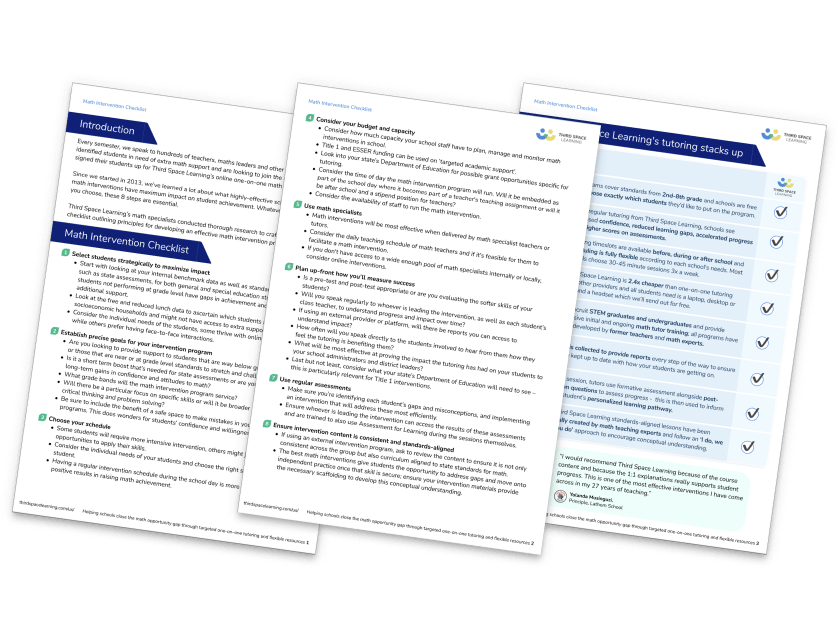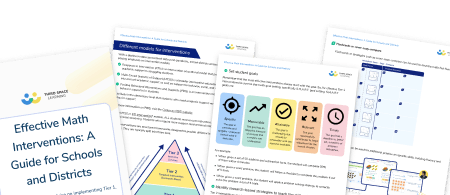Tier 3 Interventions: A School Leader’s Guide for Practical Implementation
Tier 3 interventions focus on personalized strategies for students who require intensive assistance to meet learning targets. But, with 20 or more to a class, addressing the diverse needs of individual students through Tier 3 interventions can be challenging.
In this article, we look at the role Tier 3 intervention plays in academic success, challenges and the steps to carrying out a successful Tier 3 intervention.
What are Tier 3 interventions?
Tier 3 interventions are the third stage or tier of Response to Intervention (RTI) or Multi-Tiered System of Supports (MTSS). These tiered interventions are structured frameworks designed to provide different levels of support to students.
The three tiers are:
- Tier 1 intervention involves universal strategies for all students in both general education and special education.
- Tier 2 intervention provides targeted support for students at risk of falling further behind.
- Tier 3 intervention concentrates on intensive interventions and support for students with significant challenges.
The third tier may include students with disabilities and Individualized Education Plans (IEPs), or students that suffer from extreme behaviors and attendance issues.
Positive Behavioral Interventions and Supports (PBIS) is also linked to MTSS and RTI. Often, students who need academic support need behavior support too.
Together, an academic intervention plan and a behavior intervention plan accelerate student progress.
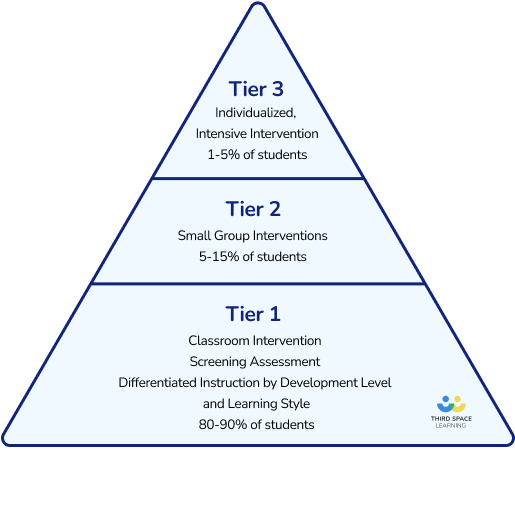
Effective Math Interventions: A Guide for Schools and Districts
A guide for school leaders to implementing successful Tier 1, Tier 2, and Tier 3 math interventions, with detailed recommendations and examples for each tier
Download Free Now!Why are Tier 3 interventions so significant?
Tier 3 interventions are the most individualized and intensive of the three tiers. It is there to support students with significant needs, including those with disabilities or IEPs.
Tier 3 intervention is based on six key components:
- Personalized support:
Tier 3 interventions are extremely individualized interventions that cater to the specific needs of individual students.
Intervention is not one size fits all. Tier 3 intervention is specifically tailored to address academic, behavioral and social emotional challenges that prevent students from progressing.
- Early identification and prevention:
Implementing Tier 3 interventions allows teachers to identify struggling students very early on.
Recognizing student struggles and challenges at their onset can prevent an escalation of struggles that may widen the achievement gap. This also promotes a proactive approach to learning support.
- Maximizing learning potential:
For struggling students, Tier 3 interventions provide extra scaffolding needed to gain an understanding of complex concepts.
Personalized assistance empowers students to reach their full learning potential, bridging gaps that prevent academic progress.
- Data-driven decision making:
Tier 3 interventions rely heavily on data-based decision making processes.
Frequent functional behavior assessments and academic progress monitoring enable teachers to modify and adapt interventions based on students’ evolving needs.
This approach ensures that interventions are relevant, address the individual needs of students and remain highly effective.
- Emphasis on collaboration:
Effective Tier 3 interventions require collaboration between teachers, intervention specialists, educational leaders, and parents.
Through a team approach, schools can create a learning environment where expertise is shared and a collective effort is aimed at supporting students.
- Addressing social emotional needs:
Tier 3 interventions also support the social and emotional well-being of students. Many students who face academic challenges may suffer from poor mental health and require emotional support.
Using research-based strategies, Tier 3 interventions take on a holistic approach to address both the academic and emotional needs of students.
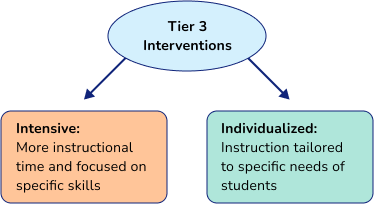
Why do you need Tier 3 interventions?
Tier 3 interventions target students facing challenges that go beyond the scope of general support. These interventions are necessary for students who continue to struggle after receiving Tier 1 universal strategies and Tier 2 intervention targeted assistance.
Tier 3 provides frequent, intensive and individualized interventions. A one-size-fits-all approach is not sufficient.
Implementing a personalized support system helps these interventions address specific learning gaps and overcome obstacles in their learning. In turn, this improves behavioral and academic outcomes.

Meet Skye, the voice-based AI tutor making math success possible for every student.
Built by teachers and math experts, Skye uses the same pedagogy, curriculum and lesson structure as our traditional tutoring.
But, with more flexibility and a low cost, schools can scale online math tutoring to support every student who needs it.
Find out moreHow do Tier 3 interventions work?
Tier 3 interventions are the final stage of a multi-tiered system of support. They provide specialized assistance to students that face significant academic, behavioral, and emotional challenges.
There are 3 stages to ensure Tier 3 interventions work:
- Data collection
Through a series of assessments and data collection, teachers identify the individual needs of the the student. - Individualized strategies
Based on the data, educators and intervention specialists collaborate to design and implement highly individualized strategies, often involving one-on-one or small group sessions. - Progress monitoring
Regular progress monitoring and data analysis are help educators assess the effectiveness of an intervention and adapt to the needs of students accordingly.
Successful Tier 3 interventions hinge on interventions focusing on the unique needs of each student.
Steps for successful Tier 3 interventions
Creating a successful Tier 3 intervention program involves systematic intensive support. All stakeholders must use a collaborative approach to maximize student success.
Here are 10 steps school districts can follow to create a successful Tier 3 intervention:
1. Comprehensive assessment
Administer a universal screening of each student’s academic, behavioral, and emotional needs. Use the data to identify any areas that require intervention.
2. Individualized learning plans (ILPs)
Develop individualized learning plans for each student based on the assessment results. Evidence-based interventions should outline specific goals, strategies tailored to address student’s unique needs.
3. Highly qualified personnel
Ensure that teachers and intervention specialists involved in Tier 3 interventions are highly qualified, trained, and equipped to deliver the level of individualized support that is required.
4. Clear communication and collaboration
Encourage open communication and collaboration among all stakeholders – teachers, specialists, parents, educational leaders, and any relevant support staff.
5. Data-driven decision making
Monitor and analyze data to make informed decisions about the effectiveness of the interventions. Adjust intervention strategies based on the ongoing assessments so that interventions are aligned to students’ needs.
6. Professional development
Provide ongoing professional development for teachers and intervention specialists to ensure they stay up-to-date on best practices and research-based interventions.
7. Parental involvement
Engage parents in the intervention process; constantly communicate and share student progress, as well as explain ways parents can support intervention at home.
8. Flexible scheduling
Create and implement a flexible schedule that accommodates the additional time and resources needed for Tier 3 interventions.
9. Evaluation
Regularly evaluate the overall effectiveness of the Tier 3 intervention program by assessing student progress and analyzing student outcomes.
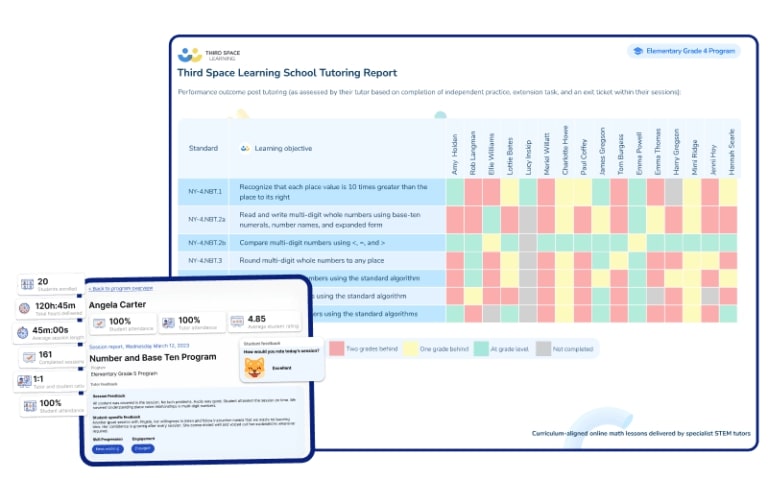
10. Celebration
The most important step – acknowledge and celebrate the successes and progress achieved by students through the Tier 3 interventions. This helps to boost confidence and encourage students.
Read more: 9 Math intervention strategies
What are the challenges of Tier 3 interventions?
While the results of Tier 3 interventions can be hugely successful, implementing a multi-tiered system of support has its own share of challenges, including:
- Staffing
Finding enough qualified staff to implement Tier 3 interventions can be challenging for school districts. It might require the district to train existing staff or hire new personnel.
- Resources
Tier 3 interventions require significant resources, including personnel, time, and funding. School districts may struggle to allocate these resources, especially if they are already stretched thin.
- Data collection and monitoring
Collecting and analyzing data to identify student needs and track their progress can be time consuming and complex — adding to teachers already intense workload.
- Scheduling for collaboration
Effective Tier 3 interventions require collaboration among teachers, administrators, counselors, and parents. Scheduling and coordinating meetings can be challenging for school districts.
- Parental involvement
Engaging parents or guardians in Tier 3 interventions is essential. But communication and collaboration are not always easy, especially with parents and guardians who do not respond to phone calls or emails.
- Sustainability
Maintaining Tier 3 interventions over time and ensuring their long-term effect can be difficult, especially if there is a change to staff, leadership or funding.
Addressing these challenges requires careful planning and a commitment from school districts to make Tier 3 interventions a priority to meet the diverse needs of students.
With Third Space Learning, multiple students can access personalized one-on-one math intruction at once. Because our math interventions take place online with AI math tutor, Skye, schools have access to all the highly trained math specialists they need.
Schools can choose the frequency and length of their one-on-one math tutoring sessions depending on the needs of the learner, meaning more intensive interventions are available for those who need them most.
How can US school districts support sustainable Tier 3 interventions?
School districts need to commit to supporting RTI and MTSS to make Tier 3 interventions sustainable.
Several approaches school districts can take to ensure Tier 3 intervention is sustainable include:
- Budget: School districts can allocate resources for intervention programs, including staffing. Conducting a school-wide needs assessment across the district can help to prioritize a commitment to Tier 3 interventions.
- External funding: Grant opportunities, partnerships and state or federal funding from the US Department of Education can help districts provide the sustained support needed to boost student learning.
- Optimizing resources: Reassessing school funding options and existing resources based on data-driven information ensures a more efficient use of financial resources. Reallocating funds and resources as required supports the sustainability of implementing evidence-based Tier 3 interventions.
Find out how you can use ESSER, ESSA and Title 1 funding to help contribute to the cost of Third Space Learning’s personalized one-on-one tutoring for underprivileged students.
Effectively integrating technology and data into Tier 3 interventions
Technology is essential for the success of Tier 3 interventions. Educators need digital platforms and assessment tools to gather real-time, actionable data on individual students and their progress.
Digital tools encourage a quicker response to intervention and adjustment of ineffective strategies. Recording data digitally allows educators to quickly use graphs to assess students’ responsiveness to individualized intervention strategies and adjust accordingly.
In turn, digital progress monitoring makes it easier for educators to tailor the content to each student’s needs, providing targeted and engaging support.
Digital tools make communication among teachers, specialists, and parents easier. This ensures a cohesive and coordinated approach to intervention.
How can Third Space Learning support your math interventions?
Third Space Learning provides online one-on-one math interventions, designed by math specialists, that are personalized to each student’s needs.
Our highly trained AI math tutor uses pre-assessment, assessment for learning and post-assessment to monitor student progress and personalize learning in real-time to ensure maximum student achievement.
Math instruction focuses on grade-level math skills with an emphasis on problem solving to help develop students’ critical thinking.
Find out more about why thousands of schools choose Third Space Learning as their tutoring provider.
Tier 3 interventions ensure that no student is left behind. By recognizing the diverse needs of learners and tailoring interventions to their needs, teachers promote academic success for everyone.
FAQs
Tier 3 math intervention programs are specialized, more intensive interventions designed to support students who struggle with mathematical understanding.
Students in Tier 3 typically require individualized attention and targeted assistance beyond what is provided in a general education setting or even Tier 2 group intervention.
Here are several examples of Tier 3 interventions:
– One-on-one Individualized instruction that addresses the specific needs of that student.
– Intensive focused and targeted small-group sessions of 2-3 students. These sessions address specific learning gaps or challenges shared by a small, select group performing at the same student level.
– Personalized learning paths that outline specific goals and strategies based on student outcomes.
Specialized counseling or mental health services for students to address emotional or psychological factors.
– Behavioral support plans that address problem behaviors or behavioral challenges that impact a student’s academic performance.
The length of Tier 3 interventions can vary based on the specific needs of the students and the nature of the intervention. Typically, intervention sessions can range from 30 to 60 minutes. As they are more intensive and individualized support, they may necessitate longer sessions.
Tier 3 intervention is often one-on-one instruction or support. The focus of Tier 3 is on providing highly individualized and intensive interventions for students with significant academic, behavioral or social-emotional challenges.
Do you have students who need extra support in math?
Skye—our AI math tutor built by experienced teachers—provides students with personalized one-on-one, spoken instruction that helps them master concepts, close skill gaps, and gain confidence.
Since 2013, we’ve delivered over 2 million hours of math lessons to more than 170,000 students, guiding them toward higher math achievement.
Discover how our AI math tutoring can boost student success, or see how our math programs can support your school’s goals:
– 3rd grade tutoring
– 4th grade tutoring
– 5th grade tutoring
– 6th grade tutoring
– 7th grade tutoring
– 8th grade tutoring
